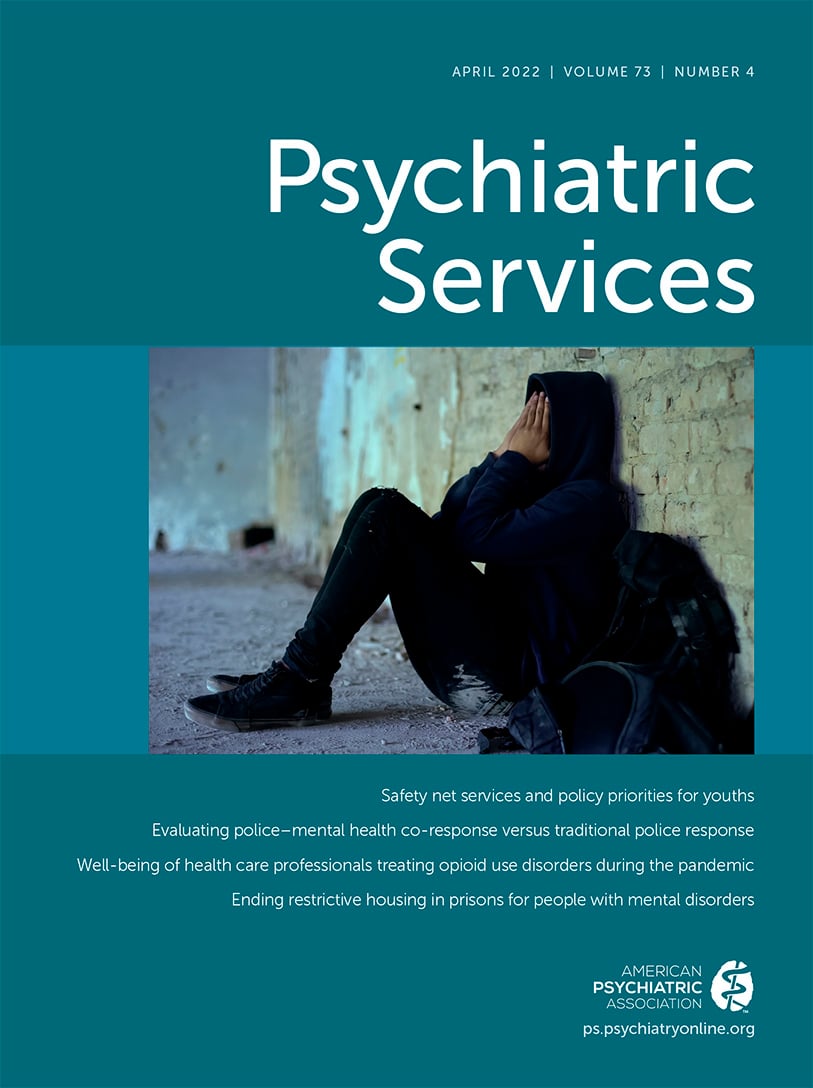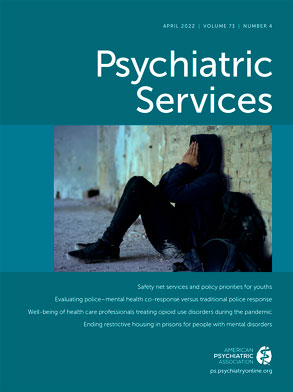Benefits and Drawbacks of Police Integration Into Assertive Community Treatment Teams
Abstract
Objective:
Methods:
Results:
Conclusions:
HIGHLIGHTS
BOX 1. Descriptions of assertive community treatment (ACT)–related programs
ACT
Forensic ACT (FACT)
Police integration into ACT teams (ACT-PI)
Methods
ACT-PI Officers
Participants
ACT-PI clients.
BOX 2. Characteristics of participating clients
ACT-PI staff.
Recruitment
ACT-PI clients.
ACT-PI staff.
Procedure
Measures
Data Analysis
Results
Benefits
| Theme | Description | Client example quotation | Staff example quotation |
|---|---|---|---|
| Relationship building | Clients and staff reported that ACT-PI officers’ abilities to develop long-term, empathic relationships with clients were key to the ability of officers to support clients’ stability and well-being. | “Let’s just say, like, I got into trouble with the law. . . . [The ACT-PI officer would] be someone you could talk to and find out what was going on and all that . . . someone that would treat you with respect.” | “At first, you would think that the clients would be not wanting [the police] around, but these officers are streetwise, they know how to talk to people, and our clients figure out they’re there for them.” |
| Improving safety | Clients and staff reported that they felt an increased sense of safety in ACT-PI offices and in the community. | “When the police are there, I feel much safer . . . they’re not bullies in any way or anything like that, but, you know, they put their foot down when they need to. . . . That gives me a peace of mind and security.” | “If I did not have . . . officers on the team, and I had to rely on . . . peer support . . . for safety, or to help me work with a situation of conflict . . . I would probably quit. I would not feel safe anymore.” |
| Embeddedness | Clients and staff reported that officers’ integration into the team resulted in more coordinated care and better outcomes for clients. | “They all seem to be of the same mindset, so they’re all working as one . . . they’re just one great, good team.” | “We have an opportunity with our police officers to say, ‘This person’s doing this, but you need to understand what’s happened to this client in their life, or in the last few days, for this behavior to maybe make a bit of sense.’” |
| Prevention oriented | Clients and staff described officers’ ability to identify and prevent client issues before they escalated into serious problems. | “[The ACT-PI officers] are looking for a solution. They’re like, ‘You’re homeless, what are we going to do?’ rather than ‘Get the hell out of here, now.’” | “We’re also able to get people up to the hospital more quickly when they’re decompensating because we have police officers here. If somebody was not doing well with their mental health status, and I just said, ‘Oh, I gotta get them up to the hospital,’ the difference is between me waiting an hour for police to come . . . if I have to wait an hour, something bad is going to happen.” |
| Authority | Staff noted that ACT-PI officers set boundaries and educated clients about the potential consequences of their actions, often reducing the risk that client behavior would escalate. | “With the officers it’s pretty straight and cut and dried, and so . . . after having a few dealings, the client knows, ‘OK, well this is how it’s gotta go.’” |
Relationship building.
Improving safety.
Embeddedness.
Prevention oriented.
Authority.
Drawbacks
| Theme | Description | Client example | Staff example |
|---|---|---|---|
| Risk for consequences | Clients expressed concern that the presence of police could increase the risk for criminal sanctions for clients. | “[Other clients] are not very happy with the fact that . . . ACT teams are working with police involvement, because . . . now they don’t have any safety. They’re always at risk of being arrested. They’re always at risk of being put in jail, put on probation.” | |
| Police stigma | Several clients and staff noted that being seen with police can lead to perceived public stigma toward clients from peers and the larger community due to the perception that clients are informants or dangerous in some way. | “People start seeing me talking to [an ACT-PI officer] at McDonald’s, and . . . it brought me problems because people thought I was a rat because I was talking to a cop.” | “I don’t think that we’re criminalizing clients with mental health issues, but it does send for some a message that ‘maybe you’re dangerous’ when the client’s may be not dangerous. . . . I worry a little bit that . . . we now have police officers . . . that we’re giving the message to the public, well, ‘You better watch out.’” |
| Escalating distress | Clients and staff expressed concern that police presence could be an emotional trigger for clients with a history of negative interactions with the police. | “I think some people who have had extensive negative experience with the police may be very hesitant to open up with a police officer present. . . . There’s a lot of hatred. If you’ve been beaten up, like, 10 times, you’re not going to be like, ‘Oh, yay,’ right?” | “Certainly, police can maybe have an inflammatory effect on certain interactions; like, they can be a trigger for negative behaviors from some of our clients who may have had negative interactions with police.” |
| Low availability | Several clients and staff expressed concern that officers were not always available when needed. | “[The ACT-PI officer has] too many things to do because there’s always . . . another person that needs something.” | “The only downside . . . I wish that we had them 7 days a week. . . . We don’t have police assistance on Saturdays and Sundays, and there’s always things that [go wrong] on Saturdays and Sundays.” |
| Changed teams | One staff member expressed concern that officer involvement might lead to changes to the way the program is administered. | “The focus of the teams may change to those with more of a criminal violent forensic background, and I am concerned that we might lose . . . those equally needy individuals who have mental illness, or mental illness and substance use, [who] may not be causing such a societal visible problem, but might just equally need that intensive outreach approach.” |
Risk for consequences.
Police stigma.
Escalating distress.
Low availability.
Changed teams.
Discussion
Limitations
Future Directions
Conclusions
Supplementary Material
- View/Download
- 147.96 KB
References
Information & Authors
Information
Published In
History
Keywords
Authors
Competing Interests
Funding Information
Metrics & Citations
Metrics
Citations
Export Citations
If you have the appropriate software installed, you can download article citation data to the citation manager of your choice. Simply select your manager software from the list below and click Download.
For more information or tips please see 'Downloading to a citation manager' in the Help menu.
View Options
View options
PDF/EPUB
View PDF/EPUBLogin options
Already a subscriber? Access your subscription through your login credentials or your institution for full access to this article.
Personal login Institutional Login Open Athens loginNot a subscriber?
PsychiatryOnline subscription options offer access to the DSM-5-TR® library, books, journals, CME, and patient resources. This all-in-one virtual library provides psychiatrists and mental health professionals with key resources for diagnosis, treatment, research, and professional development.
Need more help? PsychiatryOnline Customer Service may be reached by emailing [email protected] or by calling 800-368-5777 (in the U.S.) or 703-907-7322 (outside the U.S.).

